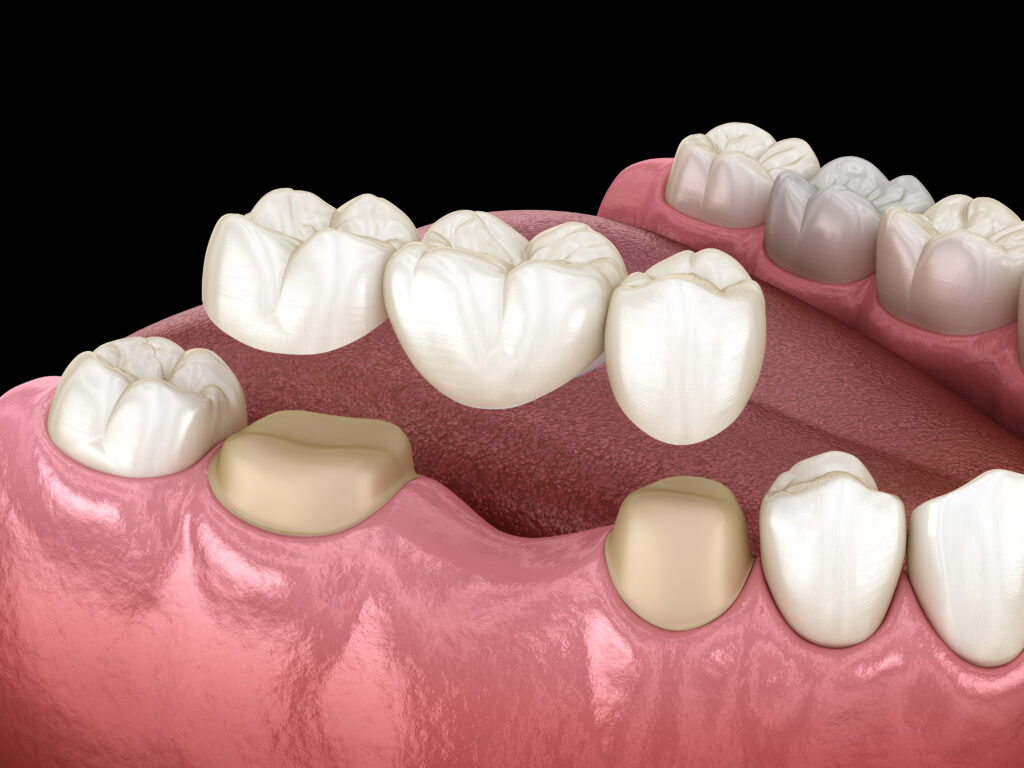Menu
A dental bridge can replace one or more missing teeth and help restore your confidence. They consist of a false tooth positioned between two crowns filling the gap and will slot over the teeth either side of a gap (known as abutment teeth) or alternatively they can be held in place by dental implants. They are usually made from porcelain fused to a metal or ceramic base, to offer a blend of strength and a natural look.
This procedure usually requires two visits to the dentist. The first step involves examining and preparing the teeth to support the bridge.
The dentist will use a scanner to scan the prepared teeth which will be used to custom-make a bridge which will fit exactly over the prepared teeth. Depending on the chosen material, a dental bridge can be closely matched in shape and colour to the original teeth, making it seamless.
While the bridge is being made you will be fit a temporary bridge. The second visit involves placement of the permanent bridge. The bridge is checked and adjusted to make sure it fits perfectly, and it is finally fixed in place with strong dental cement.
It is important you clean your bridge every day, to prevent problems such as bad breath and gum disease. You also must clean under the false tooth every day. Your dentist or hygienist will show you how to keep your bridge clean and fresh.
If bridges are looked after well, including keeping the surrounding teeth healthy, they can continue to provide a solid foundation for over ten years.
There are a few different options for dental bridges, but the most common type involves placing crowns on two or more teeth adjacent to your missing teeth for support. Placing crowns for bridges means removing otherwise healthy tooth structures in order to attach crowns to them.
There are certain situations when the teeth needed to support the bridge might not be strong enough to support a bridge.
Dental implants are however considered the gold standard when it comes to replacing a missing tooth. If more than one teeth are missing, the space can be restored by implant supported bridges. Our dentists will go through all the options with you and suggest the right way to replace missing teeth.
No, the false tooth is attached to the adjacent teeth and, once placed, will stay in your mouth, unlike a denture.
Whatever type of bridge you have, it is essential you follow a good oral hygiene routine and clean around your bridge by brushing and flossing. You will need to keep regular appointments with your dentist and hygienist. If the bridge is not kept clean, gum disease and decay could develop around the tooth carrying the bridge and eventually failure of the bridge.
When deciding how to fill the space left by a missing tooth or teeth, we need to take into account many factors including the following:
Our practice offers a finance option for all specialists and extensive courses of treatment. Interest-free options are available between 6 and 12 months. For more information, click below or call us on 01264 771114.
We provide a practice care plan membership that may help you pay for the cost of your dental treatments. Our plan includes your routine dental examination, hygiene sessions, x-rays and emergency appointments. A good method to budget for the expense of your regular dental treatment.


The surgery has been established for thirty years and is a busy, thriving private practice offering excellent cosmetic and routine dentistry for the whole family. The emphasis of care is on quality and an ethical approach promoting education and prevention. Care for all the generations is a priority and high standards of cross infection control are paramount.
We’re offering free consultations, complimentary iTero scans, and exclusive treatment plans tailored just for you. Curious about how Invisalign can transform your smile? Book a call today and take the first step towards straighter, healthier teeth.
💡 Limited-time offers and promotions available at selected times — ask us for details!